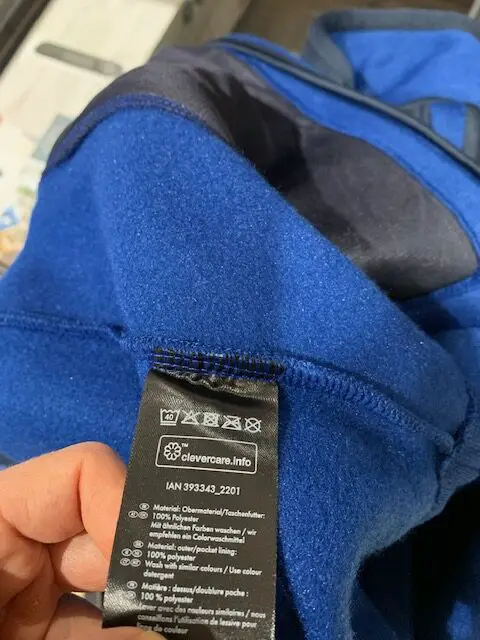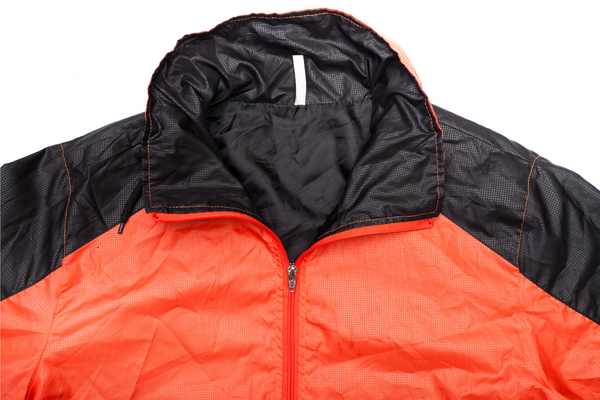Wearing a windbreaker can make all the difference when you’re out hiking or camping. But with all of their features and benefits, it’s important to know how to properly care for your windbreakers.
Windbreakers are often made from nylon or polyester, which are synthetic materials that can be washed but you need to be careful.
Synthetic windbreakers do not tolerate as high heat as thicker (e.g. cotton) jackets do and they should not be washed above 104F (40C) in a washer.
Preferable, you should wash them by hand, but sometimes it makes sense to machine wash a windbreaker as you can clean it and add a waterproofing detergent in one go.
Washing and drying them correctly will ensure that they last longer so you can enjoy them for many outdoor adventures!
In this blog post, we’ll discuss if and how you should wash your windbreakers – including tips on washing by hand as well as in the washer and dryer – plus other considerations like heat pressing or shrinking a windbreaker on purpose!
So read on to learn more about caring for your beloved windbreakers!
Contents
Can You Wash Windbreakers?
Windbreakers are a popular choice for outdoor enthusiasts due to their lightweight, water-resistant material.
Yes, you can certainly wash a windbreaker!
However, you have to keep in mind that they do not tolerate high heat and high centrifugation settings.

Windbreakers are often made from synthetic materials like polyester and nylon, which makes them somewhat harder to wash than for example cotton.
While it is possible to wash windbreakers in a washing machine, there are certain precautions that should be taken when doing so.
They should not be bleached or heated to more than 40C (104F) and most do not tolerate the dryer.
So Should I Wash My Windbreaker
When washing windbreakers, the gentle cycle and cold water should always be used. Additionally, fabric softener or bleach should not be used as these can damage the material of the windbreaker.
After washing, air drying is recommended as opposed to using a dryer as this will help preserve the shape and color of the garment.
If necessary, you can use a very low heat setting on your dryer but make sure to check inside pockets before doing so in order to avoid melting any zippers or buttons.
How Often Do You Wash Windbreakers?
Most people find that they only need to wash their windbreaker every few months depending on usage and environment conditions such as rain or snowfall exposure levels.
However, if you notice dirt buildup or an unpleasant odor, it may be necessary to wash more frequently than usual in order to ensure proper hygiene standards are met while also preserving the quality of your garment over time.
If you take good care of your windbreaker it will be able to last you many years to come!
Key Takeaway: When washing windbreakers, it is important to use the gentle cycle and cold water setting on your machine. Additionally, fabric softener or bleach should be avoided as these can damage the material of the garment. After washing, air drying is recommended in order to preserve shape and color. Generally speaking, a windbreaker should only need to be washed every few weeks depending on usage and environmental conditions but if dirt buildup or an unpleasant odor occur then more frequent washes may be necessary.
Can You Put Windbreakers in the Washer?
Yes, most windbreakers can also be washed, even if they have some degree of down insulation.
You can put windbreakers in the washer but it is important to use the gentle cycle and cold water. Windbreakers are usually made from polyester which means they should not be washed over 104F.
If you wash your windbreaker too often or with too high of a temperature, it may pill or the colors might fade. Additionally, it is best to avoid using fabric softener or bleach as these can damage the material.
When washing your windbreaker in a machine, make sure that there are no other items in the load that could snag on your jacket such as zippers or buttons.

It is also recommended to use a mesh laundry bag so that any loose threads don’t get tangled up with other items during washing and drying cycles.
Alternatively, you can add some soft objects like towels or bed sheets alongside the windbreaker in the washer.
After washing, hang dry your windbreaker instead of putting it into a dryer as this will help preserve its shape and color better than if dried at high temperatures for an extended period of time.
If you want to hand-wash your windbreaker instead of using a machine, fill up a sink with lukewarm water and add some mild detergent specifically designed for delicate fabrics like polyester.
Do not use harsh chemicals such as bleach. Gently swish around until all areas have been covered by suds before rinsing off thoroughly under running water until all soap has been removed from the garment’s surface area.
Then lay flat on top of towels (not terry cloth) and roll them together gently pressing out excess moisture without wringing out fabric fibers; this will help prevent stretching out or shrinking down sizes when drying fully outside away from direct sunlight exposure for best results.
Although it is generally not recommended to put windbreakers in the washer, there are some special care instructions that can help you safely clean your windbreaker. Next, we’ll explore how to properly wash a windbreaker by hand.
Key Takeaway: When washing windbreakers, it is important to use the gentle cycle and cold water. Avoid using fabric softener or bleach, as well as any other items that could snag on your jacket such as zippers or buttons. Hand-washing is also an option: fill up a sink with lukewarm water and mild detergent specifically designed for delicate fabrics like polyester, then lay flat on top of towels and roll them together gently pressing out excess moisture without wringing out fabric fibers. Finally, dry outside away from direct sunlight exposure for best results.
Can You Put a Windbreaker in the Dryer?
Yes, you can put a windbreaker in the dryer but only at very low heat as high heat can cause shrinkage and damage to the material. Most windbreakers are made from polyester which should not be dried over 105F.
Most windbreaker labels will tell you not to dry your windbreaker in the dryer, but my experience is that it can be done without damaging your windbreaker if you use low temperatures and a gentle rotating.
When drying your windbreaker, avoid using high temperatures as this could cause irreversible damage to the fabric.
The best way is to hang it up on a clothesline or lay it flat on a towel so that air can circulate around it and help speed up drying time without risking any shrinkage or fading of color due to excessive heat exposure.
If you’re short on time, try using an old pillowcase when putting your windbreaker in the dryer – this will act as a barrier between direct contact with heated metal surfaces inside the drum while still allowing for some circulation of air around your garment during tumbling cycles.

Make sure you don’t leave anything inside for too long though; remove items promptly once they have finished their cycle and hang them up immediately afterwards so they don’t wrinkle unnecessarily while cooling down after being exposed to warmth from within the appliance itself.
In addition, try not to overload your dryer with too many garments at once.
Having fewer items will allow more space for air circulation which helps reduce chances of shrinking due to overheating caused by lack of ventilation within its interior walls during operation periods.
This also applies when washing. Remember to read care labels before attempting any cleaning processes.
Key Takeaway: When drying a windbreaker, it is important to use low temperatures as high heat can cause shrinkage and damage the material. Use soft objects to beat the windbreaker into shape.
How to wash a windbreaker by hand
Washing a windbreaker by hand is an easy and effective way to keep your jacket looking its best.
Windbreakers are usually made from polyester, which means they should not be washed in temperatures over 104F.
Machine washing a windbreaker too often can cause pilling or fading of the colors, so consider hand washing it instead if not too dirty.
Here’s how you can wash your windbreaker by hand:

Gather Supplies: You’ll need a mild detergent, such as Woolite, warm water, and a clean cloth or sponge for scrubbing. Avoid using bleach or fabric softener as these may damage the material of the windbreaker.
Prepare Your Windbreaker: Before washing your windbreaker, check all pockets for any debris that could potentially stain it during the washing process.
If there are any stains on the fabric itself, pre-treat with a stain remover before beginning to wash it by hand.

Fill Basin With Water: Fill up a basin with lukewarm water (not hot) and add 1/4 cup of mild detergent into it; stir until dissolved completely in the water before adding your garment(s).
Submerge Your Windbreaker Into The Water: Place your windbreaker into the soapy mixture and let soak for 10 minutes to allow dirt particles to loosen up from fibers of fabric easily while agitating gently if needed; do not rub harshly against fabric as this will cause further damage!
After soaking for 10 minutes, rinse off all soap residue thoroughly under running tap water. Hang dry away from direct sunlight exposure; never put wet garments inside clothes dryer.
Once fully dried out (usually takes about 12 hours), store away neatly folded inside closet shelf until next use.
By following the steps outlined above, you can easily and safely clean your windbreaker by hand. Now let’s look at how to dry a windbreaker properly.
Key Takeaway: Washing a windbreaker by hand is an easy way to keep your jacket looking its best. To do so, you will need mild detergent, warm water and a clean cloth or sponge. Before washing, check pockets for debris and pre-treat any stains with a stain remover. Fill up a basin with lukewarm water and add 14 cup of mild detergent before submerging the garment into the mixture. After soaking for 10 minutes, rinse off all soap residue thoroughly under running tap water then hang dry away from direct sunlight exposure until fully dried out (about 2 hours). Finally store neatly folded inside closet shelf until next use.
Can You Heat Press A Windbreaker?
Heat pressing a windbreaker is not recommended as it can cause shrinkage and damage to the material.
Heat pressing may also remove any waterproofing that has been applied to your windbreaker, making it less effective in wet weather conditions.
When heat pressing fabric, temperatures of up to 230F are typically used. This is too hot for most polyester-based fabrics such as those found in many windbreakers.

The high temperature can cause the fibers of the fabric to break down and become brittle over time, leading to cracking or tearing of the garment.
Additionally, some dyes used on these garments may fade when exposed to high temperatures like this.
It’s important to note that even if you don’t plan on heat pressing your windbreaker yourself, there are other processes which could be done at a professional dry cleaner which could have similar effects – so always check with them before having anything done!
If you want your windbreaker looking its best without risking damage from heat pressings then hand washing is probably your best option.
A gentle hand wash and drying on a hanger will remove wrinkles as well as heat pressing does.
Hand washing will allow you more control over how much pressure and friction is applied during cleaning than machine washing would provide – meaning less risk of damaging delicate fabrics like those found in many windbreakers today.
When handwashing make sure you use cold water and mild detergent specifically designed for synthetic fabrics such as polyester – never use bleach or harsh chemicals!
After cleaning rinse thoroughly with cold water until all traces of soap have been removed before hanging out flat or tumble drying on low setting (never hang wet).
In summary, heat pressing a windbreaker is not recommended as it can cause damage due to excessive heat exposure. Therefore, it should be avoided whenever possible.
Heat pressing a windbreaker can be done, but it is important to make sure that the fabric of the windbreaker is suitable for heat pressing and that you use the correct temperature setting. Next up, we’ll look at how to choose the right windbreaker for your needs.
Key Takeaway: When cleaning a windbreaker, it is best to hand wash with cold water and mild detergent designed for synthetic fabrics. Never use bleach or harsh chemicals, and make sure all traces of soap are removed before drying. Heat pressing should be avoided as it can cause shrinkage, damage to the material, and may remove any waterproofing applied to the garment.
How to wash nike windbreaker?
The key is to make sure you follow the instructions on the care label.
Generally speaking, most Nike windbreakers are made from nylon or polyester and should not be washed at temperatures higher than 104F.
This will help ensure that your jacket does not pill or fade in color over time.
The first step in washing a Nike windbreaker is to turn it inside out and close all zippers and snaps before placing it into the washer with like colors.
Use a mild detergent designed for delicate fabrics such as Woolite or Dreft, which can be found at most grocery stores or online retailers. Set your machine on a gentle cycle with cold water and let it run its course.
Once your wash cycle has finished, remove your jacket from the washer immediately and hang dry away from direct sunlight or heat sources such as radiators or air vents.
Do not put your Nike windbreaker jacket in the dryer as this could cause shrinkage due to high temperatures; instead allow it to air-dry naturally until completely dry before wearing again.
If you’re looking for ways to keep your Nike windbreaker looking fresh longer, consider spot cleaning when needed using lukewarm water mixed with mild soap.
Blot gently with a clean cloth rather than throwing it into the washer every time something spills on it; this will help preserve its shape while also reducing wear-and-tear caused by frequent laundering cycles.
Washing your Nike windbreaker is an important part of keeping it in good condition. Now that you know how to wash it properly, let’s take a look at the best way to store your windbreaker for maximum protection.
Key Takeaway: When it comes to washing a Nike windbreaker, the key is to follow the instructions on the care label. Use a gentle cycle with cold water and mild detergent, hang dry away from direct sunlight or heat sources, and avoid using an iron set at high temperatures. To preserve its shape longer, spot clean with lukewarm water and mild soap instead of laundering every time something spills on it.
How to Wash a North Face Windbreaker?
Washing a North Face windbreaker is not as complicated as it may seem. With the right knowledge and care, you can keep your windbreaker looking like new for years to come.
North Face windbreakers are similar to those from other brands like Nike, but somewhat different from brand like Fjälräven that use more cotton in their windbreakers.
Washing Instructions
When washing a North Face windbreaker, it’s important to follow the manufacturer’s instructions on the tag of your garment. Generally speaking, most polyester-based jackets should be washed in cold water with mild detergent and tumble dried on low heat or hung dry.
Avoid using bleach or fabric softener when washing your jacket, as these products can damage its material over time. Additionally, do not wash too often; this could cause pilling or fading of colors due to excessive agitation from the machine cycle.
Spot Cleaning
If you have any small stains that need cleaning before laundering your jacket, spot clean them first with a damp cloth and some mild detergent solution.
Be sure to dab gently at the stain instead of rubbing harshly so that you don’t damage the fabric further.

After spot cleaning any stains, rinse off all soap residue thoroughly with cool water before proceeding with laundering instructions above if necessary.
Air Drying
Once you have finished washing your North Face windbreaker in cold water and mild detergent according to the manufacturer’s instructions (or spot cleaning), hang up the wet garments outside or indoors away from direct sunlight until they are completely dry.
Then, store them away in closet or drawer space for future use later on down the road.
Properly washing your North Face windbreaker will help keep it looking new and extend its life, so be sure to follow the manufacturer’s instructions. Now let’s look at how to store a North Face windbreaker.
How often should you wash windbreakers?
Washing windbreakers is an important part of keeping them in good condition and making sure they last for years.
Windbreakers are made from polyester, which means that they should not be washed at temperatures higher than 104F.
Washing your windbreaker too often can cause it to pill or the colors to fade, so you don’t want to overdo it.
The frequency with which you should wash your windbreaker depends on how often you wear it and what kind of activities you do while wearing it. If you wear your windbreaker every day or multiple times a week, then washing it once a month is recommended.
However, if you only wear your windbreaker occasionally or when doing outdoor activities such as hiking or camping, then washing it every two months may be sufficient.
Final Tips on How To Wash a Windbreaker
When it comes to washing your windbreaker, there are a few important steps you should take in order to ensure that the material is not damaged. First and foremost, make sure to use the gentle cycle on your washing machine and cold water.
Hot water can damage polyester fabric, which most windbreakers are made from. Additionally, avoid using fabric softener or bleach as these can also cause damage to the material.

After washing your windbreaker, hang it up on a clothesline or lay it flat on a towel so that air can circulate around it and help speed up the drying process.
If you do need to use a dryer for some reason, set it at low heat and remove immediately after drying is complete.
To keep colors vibrant over time, it is best to wash with like colors only and try not to wash too often. Doing so may cause pilling of the fabric or fading of colors due to excessive exposure to detergents and hot water cycles.
If possible, spot clean any dirt marks rather than subjecting an entire garment unnecessarily through multiple washes when only one area needs attention.
After washing your windbreaker, it’s important to let it air dry properly before wearing or storing. Now that you know how to wash a windbreaker, let’s look at the best ways to store one.
Can You Shrink A Windbreaker On Purpose?
No, you should not attempt to shrink your windbreaker on purpose. Windbreakers are usually made from polyester and nylon materials which can be damaged by excessive heat.
If the fabric is exposed to temperatures higher than 230F, it may cause irreversible damage to its material and waterproofing properties.
They will not usually shrink in a regular proportional fashion, but rather crumble up and get damaged at too high temperatures.
Furthermore, if a windbreaker is washed too often or in hot water, it could lead to pilling of the fabric and fading of colors.
Tips For Maintaining Your Windbreaker For Years To Come
To help maintain your jacket, regularly spot clean stains before they set in permanently – especially after outdoor activities like camping where dirt may accumulate quickly on certain areas of the garment such as around cuffs/sleeves etc.
A well kept windbreaker should be able to last you 5-10 years, depending on your use!
Additionally, when not being worn store your jacket properly to keep its shape intact – try hanging up rather than folding away into drawers etc., this will help prevent creasing along seams/zippers which can weaken their strength over time and lead to tears/rips occurring more easily later down the line when put under strain from regular use outdoors etc.

It’s important to keep your windbreaker clean and in good condition, so make sure to wash it regularly according to the manufacturer’s instructions. Next up, we’ll look at how often you should replace your windbreaker.
Key Takeaway: Maintaining a windbreaker is important to keep it in good condition and make sure it lasts. Here are some key tips for washing and maintaining your windbreaker: • Read care instructions before washing • Hand-washing is best, but machine-washing on gentle cycle using cold water will also work • Avoid bleach and fabric softeners • Hang dry rather than tumble drying • Spot clean stains regularly, especially after outdoor activities such as camping or hiking • Store properly when not being worn – hang up instead of folding away.
Conclusion
In conclusion, windbreakers are a great way to stay warm and protected from the elements while out on hikes or other outdoor activities. It is important to know how to properly wash and dry your windbreaker in order to maintain its quality and longevity.
Washing it too often can cause pilling or fading of colors, so it’s best to follow the instructions for washing your specific brand of windbreaker.
Heat pressing and shrinking should also be done with caution as these processes may damage the fabric of your windbreaker. With proper care, you can ensure that your windbreaker will last for many years!
We all know the importance of being prepared for outdoor activities, and a windbreaker is an essential item to have on hand.







